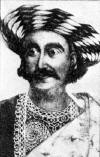|
|
||||||
|
|
|
|
||||
|
Prince Dwarkanath Tagore, grandfather of Nobel laureate Rabindranath Tagore was a rich businessman in the 40s of 19th. century. He owned quite a number of collieries in Raniganj and Rajmahal area. Dwarkanath visited England on 9th. January 1842 for the first time and had a ride on a train. He could see the great potential of the rail transport in Bengal as a commercial venture since the province was rich in agriculture and mineral resources. He visualised railways role in facilitating faster movement of goods and passenger.
|
||||||
|
After returning from England in January 1843, he
formed a company called
"Carr Tagore and Company"
and the
first seed for the railways was sown in Bengal. In the mean time
Mr. McDonald Stephenson had already floated
shares for East India Railway
Company incorporated in England. Dwarkanath wanted a railway line to his
collieries and proposed to raise one third of the capital for this portion
of the line and being unable to strike a deal, he set up his new Company called
the
Great Western
Bengal Railway Company.
It was primarily for movement of agricultural and mineral products from Raniganj and Rajmahal
Coalfields. |
||||||
|
After a visit to India in 1845 Stephenson made a proposal to the Court of Directors of East India Company for building a rail line from Calcutta to Burdwan. East India Co. considered this a "wild proposal". However, with Lord Dalhousie, the then Governor General of India, actively supporting the cause of the Railways for administrative reasons, the Court of Directors of East India Co. finally signed an agreement on 17th August,1849 with EIR for construction of a short experimental line. The main provision was that the company should be economically viable. The saga of East Indian Railway had begun. To see the progress of construction of E.I.R please click on the thumbnail on the left. Some of the important events and dates in the history of this great enterprise are given in this linked page: HOW DID IT GROW |
||||||
|
|
||||||
|
On
16th
April 1853, the Great Indian Peninsular Railway ran the first train in India,
for twenty-one miles from Bombay to Thane. The East Indian Railway (EIR) had
been formed long before that, in 1845, but for various reasons- among them the
delayed trans-shipment of engines from England and the loss of the first batch
of coaches in a shipwreck, the first train in Eastern India steamed out of
Howrah Station experimentally on 28th June 1854. It went upto Pandua,
though the line had been sanctioned upto Raniganj. |
||||||
|
COMPARISON
|
||||||
|
|
The first section of the experimental line from Howrah to Hooghly was
opened for passenger traffic on 15th. August 1854 and a fortnight later a
extension was opened up to Pundooah. During first 16 weeks no less than
109,634 passengers were carried. Following is the class wise analysis of
the traffic : First Class – 5511, Second Class – 21005 and Third Class – 83118. |
|||||
|
|
The line
to Raneegunge(Raniganj) was opened in 1855. 15 weeks after it was opened,
the number of passengers carried were on and average 12,000 per week and
the earning rose to about £ 900 a week ! |
|||||
|
|
In second
half of 1855 the revenue from coaching traffic was £ 25,000, from goods
traffic £ 6, 385 and from coal £ 7,856 and working expenses amounted to 42%
of the gross traffic receipt. Profitability improved further during the next
year. |
|||||
|
|
In 1887, the Bengal Nagpur Railway (BNR) had been
set up to take over an extant line in Central India and extend
services eastwards to Asansol. In 1857, the East Bengal Railway
(EBR) was formed to lay a track along the east bank of the Ganga to
Kushthia and then across the river to Dhaka. The line to Kushthia
was opened in 1862, ending at Calcutta at a tin-roofed station room
at Sealdah. In 1862 also, the Calcutta and South-Eastern Railway
opened a line from what was then called Beliaghata Station to
southward Port Canning. |
|||||
|
|
Line between Calcutta to Banaras was completed by December 1862. The
progress of construction of East Indian Railways was nothing short of 90
miles a year, in spite of numerous impediments. |
|||||
|
|
The bridge over Yamuna at Allahabad was opened on 15th.August 1865. A long
chain of unbroken communication was established by EIR, for the first time
in history of India, between right bank of Hooghly at Calcutta and left
bank of Yamuna at Delhi. Finally the Yamuna bridge at Delhi was opened for
traffic in 1866, this was last of the great bridges. |
|||||
|
|
Due to abundant availability of coal in Eastern India, EIR possessed an enormous and indisputable advantage over the western lines. | |||||
|
Sealdah was Calcutta's first terminal station. Set up in 1862, it had the
world's longest covered railway platform of 1000 feet. |
|
|||||
|
|
THANK YOU FOR THE VISIT Divisions : Sealdah Howrah Asansol Maldah Workshops : Jamalpur Liluah Kanchrapara |
|
||||









